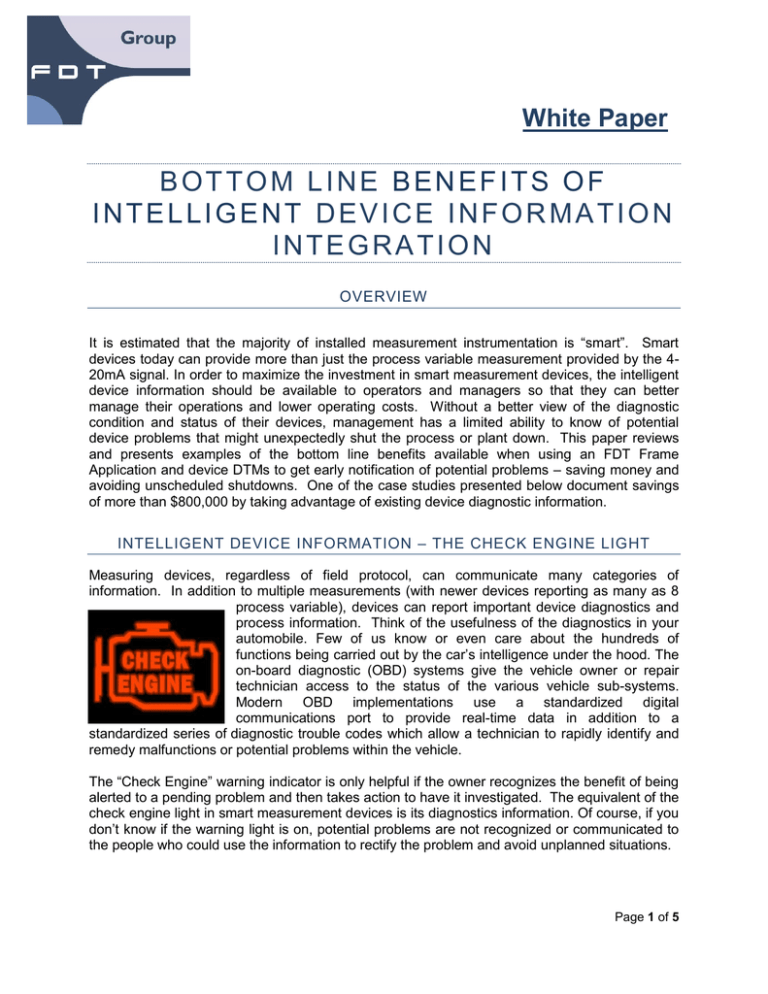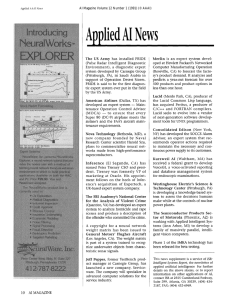Bottom Line Benefits of Intelligent Device Information Integration
advertisement

White Paper BOTTOM LINE BENEFITS OF INTELLIGENT DEVICE INFORMATION INTEGRATION OVERVIEW It is estimated that the majority of installed measurement instrumentation is “smart”. Smart devices today can provide more than just the process variable measurement provided by the 420mA signal. In order to maximize the investment in smart measurement devices, the intelligent device information should be available to operators and managers so that they can better manage their operations and lower operating costs. Without a better view of the diagnostic condition and status of their devices, management has a limited ability to know of potential device problems that might unexpectedly shut the process or plant down. This paper reviews and presents examples of the bottom line benefits available when using an FDT Frame Application and device DTMs to get early notification of potential problems – saving money and avoiding unscheduled shutdowns. One of the case studies presented below document savings of more than $800,000 by taking advantage of existing device diagnostic information. INTELLIGENT DEVICE INFORMATION – THE CHECK ENGINE LIGHT Measuring devices, regardless of field protocol, can communicate many categories of information. In addition to multiple measurements (with newer devices reporting as many as 8 process variable), devices can report important device diagnostics and process information. Think of the usefulness of the diagnostics in your automobile. Few of us know or even care about the hundreds of functions being carried out by the car’s intelligence under the hood. The on-board diagnostic (OBD) systems give the vehicle owner or repair technician access to the status of the various vehicle sub-systems. Modern OBD implementations use a standardized digital communications port to provide real-time data in addition to a standardized series of diagnostic trouble codes which allow a technician to rapidly identify and remedy malfunctions or potential problems within the vehicle. The “Check Engine” warning indicator is only helpful if the owner recognizes the benefit of being alerted to a pending problem and then takes action to have it investigated. The equivalent of the check engine light in smart measurement devices is its diagnostics information. Of course, if you don’t know if the warning light is on, potential problems are not recognized or communicated to the people who could use the information to rectify the problem and avoid unplanned situations. Page 1 of 5 INTELLIGENT DEVICE DIAGNOSTIC INFORMATION The type and amount of diagnostic information in your intelligent devices will vary by product type and supplier. Diagnostic information can be viewed as being in two categories – common and universal attributes and device specific attributes. The following is only a partial list of examples in each category so be sure to speak to your supplier to get the complete list of information and capabilities in each of your intelligent measurement devices. COMMON AND UNIVERSAL ATTRIBUTES – ALERTS AND DEVICE STATUS INFORMATION Analog and Digital process measurement values (PV) does not match – might indicate condensation (water) in the device housing Device status alerts – device malfunction, loop current fixed, PV out of limits, maintenance required, etc. Cold start or reset – potential power failure or loop power supply problems 30-40 data items – standard in most devices including 4-8 process variables and range values Remote Access – check all diagnostics from the safety of the control room or instrument shop DEVICE SPECIFIC ATTRIBUTES – DEVICE PERFORMANCE OF PROCESS INFORMATION Magnetic Flowmeter – empty pipe detection or coated electrodes, conductivity variations, etc. Pressure Transmitter – plugged impulse lines, flow rate, internal temperature, etc. pH Analyzer – electrode performance problems – reference or measurement electrodes Valve Positioner – stem position, supply or actuator pressure, total strokes, deviation from SP, etc. Vortex Flowmeter – shedder bar frequency, flow rate too low, Coriolis Mass Flowmeters – presence of trapped air, build up, etc. NAMUR (a large user organization in Europe) has a recently published guideline as to their recommendations to display or alert plant operators as to the status of field devices. By standarizing on the symbols defined in NE 107, operators can get a quick indication of the “Check Engine” status for each of their devices. The implementation and avaiability of the NE 107 recommendations is available in the FDT Style guide for suppliers developing device DTMs and Frame Applications. One of the greatest benefits of these new NE107 status funtions is the customization available based on the specific application. In general, the manufacturer defines a default mapping but the user can customize the mapping based on plant experience or the specific application. Once the configuration is complete, the status can be simulated so you can verify that the configuration matches your expectations. The key point is that these intelligent devices can provide the “Check Engine” light providing you with a better understanding of the condition or your critical devices – the ones that can shut your plant down! A skilled technician can then look at the advanced diagnostic information available Page 2 of 5 in the device to mitigate the situation. Using an FDT Frame Application and device DTM’s, you can quickly asses the status of your devices saving you time and money and improving safety and energy efficiency. MOVE FROM REACTIVE TO PROACTIVE With many updated control and asset management systems, intelligent device diagnostic information is accessible and available for immediate use. If not, there are many different costeffective products that make access to intelligent device information possible. This diagnostic information enables you to change your maintenance activities from reactive (work on what is broken) to more proactive or even predictive (fix small problems before they turn into bigger problems). Someone at the plant needs to make the commitment to access and use the information for the benefit of the operation. This is not always easy. Changing work habits is hard but in this case the return on investment is significant! Work processes have been created and might be difficult to change. But image the benefits to using real-time device diagnostic to reduce the number of trips to the field, prevent an unscheduled shutdown or reduce the length of a scheduled shutdown. Whether you are part of the reliability, maintenance, process improvement, management or other plant function, putting this valuable information to work can produce big results with relatively small investments and low-risk. This is true regardless of the age of the plant, type of control systems or size of the operation. It is also true regardless of full-time or part-time device information integration by using an asset management or device configuration software application for part-time or temporary access to information or by integrating the information full-time with your control or other automation systems. THE REAL VALUE - IMPACT TO THE BOTTOM LINE The MOL Group’s Danube Refinery in Százhalombatta, Hungary, set-out to profit using their installed smart technology in 2002, and only three years later, decided to overhaul its maintenance systems with a new, unified asset management system (AMS) strategy. The combination of the two technologies has changed the way MOL runs maintenance, and the way it looks at diagnostic data. The company set out to connect many of the plant’s smart devices, such as control valves and instruments used in critical control loops, directly into the plant’s AMS. This has resulted in an online diagnostic system in which instrument signals are directly connected to plant maintenance and control systems. To date, smart communicating devices account for 30,000 of the plant’s 40,000 instruments. Of those, roughly 3,700 of these are connected to on-line maintenance systems which are, in turn, integrated to the plant’s Asset Management System. “On-line diagnostics provided by the these instruments does something more than preventive maintenance,” says József Bartók, automation engineer at MOL Danube Refinery, adding that this “ensures the stable operation of the system and increases the precision of control.” Beyond fixing what breaks or keeping the plant running, a reliable, stable operation contributes to bottom-line profitability. Page 3 of 5 For example, when the head pressure control was slow on one unit, it led to the assumption that a valve was stuck and in need of removal and repair. But technicians, using on-line diagnostic tools, used device diagnostic data to interrogate the valve and find current-to-pneumatic damage in the intelligent positioner – but not the whole valve. Operators put the valve in manual and the fix took a half hour of instrumentation work. This saved the plant at least two days of unscheduled downtime, or at least $834,400. Before the using device diagnostics, about 60 per cent of the control valves were selected for repair in a typical plant shutdown. While all faulty valves were likely corrected, others may have been removed unnecessarily due to a lack of data. With device data, the company estimates average savings of $70,000 per unit, per shutdown – it’s no longer necessary to disassemble and repair failure-free control valves during a shutdown. Having a better handle on valve performance also allows MOL to pull fewer valves at turnaround time, substantially reducing maintenance costs and shortening the time needed before production is resumed. "Ten years ago, we pulled all of the valves," Bereznai says. "Now, we pull two dozen instead of 200, saving $20,000 to $70,000 per turnaround." At the Dow Chemical Company's complex in Deer Park, Texas, device diagnostics have helped slash plant trips attributable to instruments and control valves by 70% over the past three years, delivering "millions of dollars in savings," according to Dow's Shadrach Stephens, instrument reliability engineer, and Christopher Garcia, instrument/elec trical technology leader. In order to prioritize their efforts, Stephens and Garcia first analyzed sources of downtime and found that five reactors accounted for a full 48% of instrument- and valve-related outages. "We needed to see what the opportunity was so we could justify the necessary resources to management. Where could we make the biggest bang for the buck?" Stephens says. Their first priority was to deploy continuous monitoring for the plant's most critical control valves, which also were the biggest contributors to downtime. The plant now uses asset management software to help mitigate failures but also to push out preventive maintenance intervals, Stephens says. "We can work with operations to resolve issues without incurring downtime." "And as we get into more root cause investigations, it definitely helps to have more data," Stephens continues. "Intelligent device information helps us understand what's happening and to mitigate potential problems." Up next for Dow Deer Park is dynamic analy sis of flow Page 4 of 5 measurement data to identify and rectify issues such as fouling and plugging. "That's the next tier for us," Stephens says. CONCLUSION It is practical to want to take advantage of every possible asset we have at our disposal. The intelligence in your installed measurement devices might be one of the under-utilized assets available in your plant today. By integrating the intelligent device diagnostics into an asset management system, you begin the process of monitoring the “Check Engine” status allowing the opportunity to improve your bottom line. Using FDT Technology-enabled solutions, including a Frame Application and device DTMs that are provided by your device suppliers, you will be able to identify minor problems before they become critical – lowering maintenance and operating costs. The technology is supported and available by most major device and systems suppliers. In fact, you might be using FDT Technology today and don’t even know it. So take the first step to realize bottom line benefits of intelligent device information integration. For more information, please visit www.fdtgroup.org. Page 5 of 5



